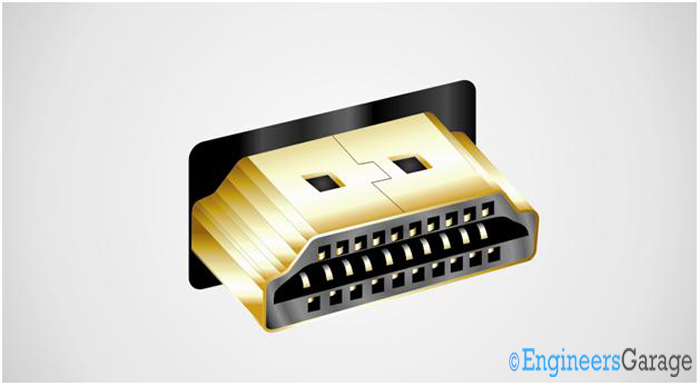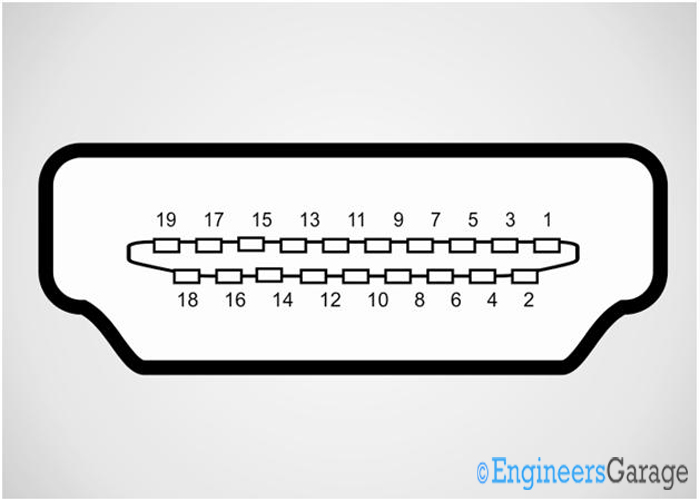HDMI stands for High Definition Multimedia Interface. HDMI is designed as an interface for the transmission of uncompressed digital audio and video. The seven companies named Hitachi, Matsushita Electric Industrial, Philips, Silicon Image, Sony, Thomson, and Toshiba together developed the HDMI in the year of 2003. It is a hot pluggable external interface supporting maximum resolution video signals and audio signals like LPCM, Dolby Digital, DTS, DVD-Audio, Super Audio CD etc. HDMI can have a maximum bit rate of 10.2 Gbit/s (340 MHz). The interface uses TMDS protocol. The HDMI specifications are defined by the Consumer Electronics Association/Electronic Industries Alliance 861 standards. In this standard five HDMI connectors are defined named type A, type B, type C and type D. All these connectors have male and female types.

Fig. 1: Image of HDMI male connector

Fig. 2: Image of HDMI female connector
Types of HDMI Connectors
Most of the HDMI connectors are electrically compatible with the DVI connectors discussed in the previous section. There are devices like HDMI to DVI converters are also available in the market.
Type A HDMI connector is defined in the HDMI 1.0 specification. It has 19 pins and is compatible with the DVI-D single link connector. This connector is designed for SDTV, EDTV and HDTV supporting devices.
Type B HDMI connector is also defined in HDMI 1.0 specification. It is a 29 pin connector which is electrically compatible with the DVI-D dual link connector.
Type C HDMI connector is defined in the HDMI 1.3 specification. It is a mini HDMI connector having 19 pins yet smaller in size than the Type A connector. This type of connectors is specifically designed for portable devices.
Type D HDMI connector is defined in the HDMI 1.4 specification. It is a Micro-HDMI connector with 19 pins yet smaller in size than both the Type A and Type C HDMI connectors. The Type D connector also differ in pin position with the Type A and Type C connectors.
Type E HDMI connector is also defined in HDMI 1.4 specification. Unlike the rest of the HDMI connector standards the Type E connectors have a locking mechanism which will keep the connection tight even in extreme vibrations. Type E connectors are hence suitable connectors for the automotive industry.
The pin position of a Type A female HDMI connector is shown in the following figure.

Fig. 3: Pin Diagram of Type A HDMI connector
The pin-out of the 19 pin HDMI Type A connector
PIN 1 ——————à TMDS Data2+
PIN 2 ——————à TMDS Data2 Shield
PIN 3 ——————à TMDS Data2–
PIN 4 ——————à TMDS Data1+
PIN 5 ——————à TMDS Data1 Shield
PIN 6 ——————à TMDS Data1–
PIN 7 ——————à TMDS Data0+
PIN 8 ——————à TMDS Data0 Shield
PIN 9 ——————à TMDS Data0–
PIN 10 —————–à TMDS Clock+
PIN 11 —————–à TMDS Clock Shield
PIN 12 —————–à TMDS Clock–
PIN 13 —————–à CEC
PIN 14 —————–à Reserved
PIN 15 —————–à SCL
PIN 16 —————–à SDA
PIN 17 —————–à DDC/CEC/HEC Ground
PIN 18 —————–à +5 V (max 50 mA)
PIN 19 —————–à Hot Plug detect
Sample specs & Summary
Sample specification:
Insulation Resistance ——————- 100M? min.
Current Rating ————————— 0.5A min.
Voltage Rating ————————— 40V AC
Withstanding Voltage —————— 500V AC
Contact Resistance ———————- 30m? max.
Operating Temperature Range —— -55°C to +125°C
Summary
{C}{C}{C}{C}{C}· {C}{C}{C}{C}{C}HDMI (High Definition Multimedia Interface) connectors’ specifications are defined in the HDMI standard HDMI 1.0 to HDMI 1.4.
{C}{C}{C}{C}{C}· {C}{C}{C}{C}{C}The HDMI connector is developed in 2003 and they have backward compatibility with the DVI connector.
{C}{C}{C}{C}{C}· {C}{C}{C}{C}{C}HDMI connectors can have a maximum bit rate of 10.2 Gbit/s (340 MHz)
{C}{C}{C}{C}{C}· {C}{C}{C}{C}{C}The five HDMI standard connectors are Type A, Type B, Type C, Type D and Type E.
{C}{C}{C}{C}{C}· {C}{C}{C}{C}{C}All the five connectors differ in their size and the pin number varies from 19 pin to 29 pin contacts.
{C}{C}{C}{C}{C}· {C}{C}{C}{C}{C}The HDMI connectors are widely used in computers, monitors, projectors, HDTV, DTH etc.
Filed Under: Tutorials


Questions related to this article?
👉Ask and discuss on Electro-Tech-Online.com and EDAboard.com forums.
Tell Us What You Think!!
You must be logged in to post a comment.